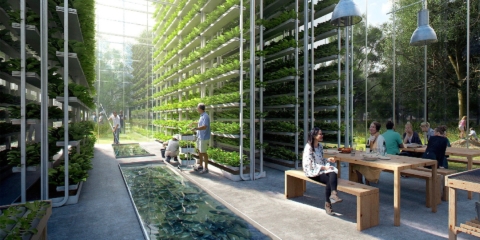Would you like to get notifications from Christian?
Imagine a future where constructing vast solar farms capable of powering thousands of homes is a process that's faster, more efficient, and almost entirely automated. This future is upon us thanks to a groundbreaking innovation from a California-based startup. They have developed an autonomous Solar Farm robot, named the RPD 35, that can construct solar farms 3-5 times faster than human crews. This transformative technology is setting the stage for a revolution in renewable energy.
Building a solar farm is traditionally a complex, time-consuming task that can take years to complete. But now, the RPD 35 robot can drastically speed up this process by autonomously installing solar piles, the foundational elements of a solar farm. Using GPS for precision, the robot can install over 200 piles in a single go, working at least three times faster than an entire human crew.
The autonomous Solar Farm robot is poised to disrupt traditional methods of solar farm construction. By autonomously and accurately placing heavy steel beams eight feet underground, the robot can perform labor-intensive tasks in less time, offering unprecedented efficiency.
This revolutionary technology is disrupting not just the speed but the entire approach to solar farm construction. Traditional methods, reliant on human crews, are now being challenged by this AI-powered marvel that can perform the same tasks only faster and with greater precision.
The introduction of the autonomous Solar Farm robot opens up a realm of exciting opportunities. As the world urgently seeks to shift towards clean energy, this robot can expedite the transition significantly.
Furthermore, the same startup has also developed an automation system for trenching underground cables that can be integrated into commercial excavators. Combining these technologies could revolutionize the entire construction industry, making it more efficient and less dependent on labor-intensive methods.

The Rise of the Autonomous Solar Farm Robot, RPD 35
The autonomous Solar Farm robot, though requiring a two-person crew to install 300 piles per day, still offers significant reductions in manpower. This could result in cost savings, making solar power more economically viable and attractive for large-scale implementation.
The impact of this autonomous Solar Farm robot goes far beyond the construction of solar farms. It's about accelerating our transition to renewable energy, reducing our dependence on fossil fuels, and ultimately mitigating the impacts of climate change.
Imagine a world where we can construct large-scale solar farms in a fraction of the required time. We could meet the increasing energy demands while drastically reducing our carbon footprint. This isn't just about creating a more sustainable world but a better world for us and future generations.
By embracing this technology, we can make strides toward a future where clean, renewable energy is the norm rather than the exception. The autonomous Solar Farm robot is not just a technological marvel; it's a tool for change, a beacon of hope for a sustainable future. Ultimately, it’s about more than just efficiency and speed it's about harnessing the power of innovation to make a meaningful difference.
Author: Christian Kromme
First Appeared On: Disruptive Inspiration Daily
Do you want more of this kind of content? Subscribe to my 'Disruptive Inspiration Daily' newsletter. Do you find this content inspiring? Give it a 'like' or share the article with your network. This will help you and your network have a relevant timeline.
Which keynote best fits your needs?


Christian is a futurist and trendwatcher who speaks about the impact of exponential technologies like AI on organizations, people, and talents. Christian tailors his presentations to your audience's specific industries and needs.



Our world is changing at an exponential rate! A big tidal wave of digital transformation and disruption is coming at us fast. Many organizations see this wave as a threat and experience stress, but there are also organizations that just see this wave as an opportunity.

Imagine sitting with just 10-15 fellow executives at a premier location, gaining clarity on the impact of AI on your industry while enjoying an exquisite dining experience. These are not just meetings—they are transformative moments that will shape the future of your organization



In the future, 3D printing and generative design will allow for products to be designed in a more decentralized manner, and production will take place closer to the customer and fully on-demand. 3D printing technology will also allow for more customization and personalization of products.


The agricultural industry is ripe for disruption. Robotics, AI, and IoT are all technologies that have the potential to radically transform the way we grow food. In combination with vertical farming, these technologies could increase the efficiency and quality of agricultural products.

A human-centered society is one that puts people first and where technology is used to unite and empower people. It is a society that values biological life and dignity above all else. It is a society that recognizes the importance of human relationships and works to strengthen them. In a human-centered society, all members of the community are valued and treated with respect.


The future of healthcare is here. New technologies like AI, IoT, big data, and smart sensors make it possible to become the CEO of your own health. Imagine that your phone can listen to your voice and AI algorithms can detect small nuances in the tone of your voice that indicate specific diseases.
